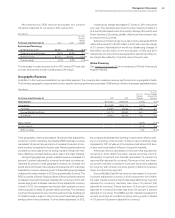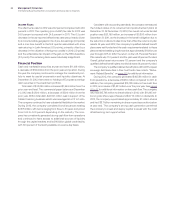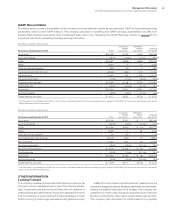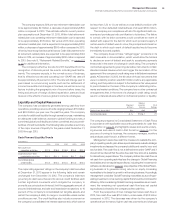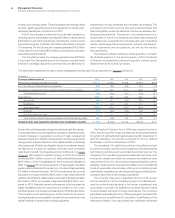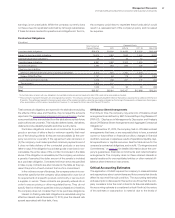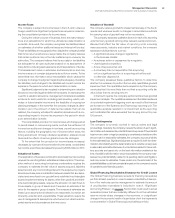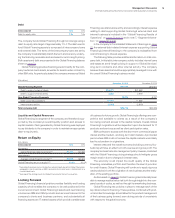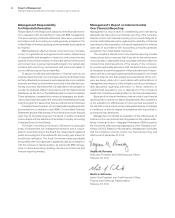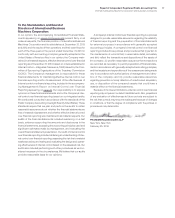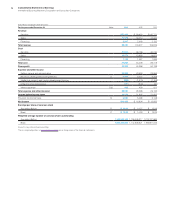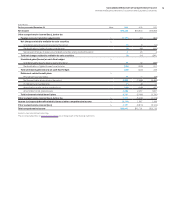IBM 2013 Annual Report Download - page 70
Download and view the complete annual report
Please find page 70 of the 2013 IBM annual report below. You can navigate through the pages in the report by either clicking on the pages listed below, or by using the keyword search tool below to find specific information within the annual report.
69
Management Discussion
International Business Machines Corporation and Subsidiary Companies
Income Taxes
The company is subject to income taxes in the U.S. and numerous
foreign jurisdictions. Significant judgments are required in determin-
ing the consolidated provision for income taxes.
During the ordinary course of business, there are many transac-
tions and calculations for which the ultimate tax determination is
uncertain. As a result, the company recognizes tax liabilities based
on estimates of whether additional taxes and interest will be due.
These tax liabilities are recognized when, despite the company’s belief
that its tax return positions are supportable, the company believes
that certain positions may not be fully sustained upon review by tax
authorities. The company believes that its accruals for tax liabilities
are adequate for all open audit years based on its assessment of
many factors, including past experience and interpretations of tax law.
This assessment relies on estimates and assumptions, and may
involve a series of complex judgments about future events. To the
extent that new information becomes available which causes the
company to change its judgment regarding the adequacy of existing
tax liabilities, such changes to tax liabilities will impact income tax
expense in the period in which such determination is made.
Significant judgment is also required in determining any valuation
allowance recorded against deferred tax assets. In assessing the
need for a valuation allowance, management considers all available
evidence for each jurisdiction including past operating results, esti-
mates of future taxable income and the feasibility of ongoing tax
planning strategies. In the event that the company changes its deter-
mination as to the amount of deferred tax assets that can be
realized, the company will adjust its valuation allowance with a cor-
responding impact to income tax expense in the period in which
such determination is made.
The consolidated provision for income taxes will change period
to period based on nonrecurring events, such as the settlement of
income tax audits and changes in tax laws, as well as recurring
factors including the geographic mix of income before taxes, the
timing and amount of foreign dividend repatriation, state and local
taxes and the effects of various global income tax strategies.
To the extent that the provision for income taxes increases/
decreases by 1 percent of income before income taxes, consolidated
net income would have decreased/improved by $195 million in 2013.
Valuation of Assets
The application of business combination and impairment accounting
requires the use of significant estimates and assumptions. The acqui-
sition method of accounting for business combinations requires the
company to estimate the fair value of assets acquired, liabilities
assumed, and any noncontrolling interest in the acquiree to properly
allocate purchase price consideration between assets that are depre-
ciated and amortized from goodwill and indefinite-lived intangible
assets. Impairment testing for assets, other than goodwill and indef-
inite-lived intangible assets, requires the allocation of cash flows to
those assets or group of assets and if required, an estimate of fair
value for the assets or group of assets. The company’s estimates are
based upon assumptions believed to be reasonable, but which are
inherently uncertain and unpredictable. These valuations require the
use of management’s assumptions, which would not reflect unantici-
pated events and circumstances that may occur.
Valuation of Goodwill
The company reviews goodwill for impairment annually, in the fourth
quarter, and whenever events or changes in circumstances indicate
the carrying value of goodwill may not be recoverable.
The company assesses qualitative factors in each of its reporting
units that carry goodwill. Among other relevant events and circum-
stances that affect the fair value of reporting units, including
macroeconomic, industry and market conditions, the company
assesses individual factors such as:
• A significant adverse change in legal factors
or the business climate;
• An adverse action or assessment by a regulator;
• Unanticipated competition;
• A loss of key personnel; and
• A more likely than not expectation that a reporting
unit or a significant portion of a reporting unit will be sold
or otherwise disposed of.
The company assesses these qualitative factors to determine
whether it is necessary to perform the two-step quantitative goodwill
impairment test. This quantitative test is required only if the company
concludes that it is more likely than not that a reporting unit’s fair
value is less than its carrying amount.
In the fourth quarter, the company performed its annual goodwill
impairment analysis. The qualitative assessment illustrated evidence
of a potential impairment triggering event as a result of the financial
performance of the Systems and Technology reporting unit. The
quantitative analysis resulted in no impairment as the reporting
unit’s estimated fair value exceeded the carrying amount by over
100 percent.
Loss Contingencies
The company is currently involved in various claims and legal
proceedings. Quarterly, the company reviews the status of each signifi-
cant matter and assesses its potential financial exposure. If the potential
loss from any claim or legal proceeding is considered probable and the
amount can be reasonably estimated, the company accrues a liability
for the estimated loss. Significant judgment is required in both the deter-
mination of probability and the determination as to whether an exposure
is reasonably estimable. Because of uncertainties related to these mat-
ters, accruals are based only on the best information available at the
time. As additional information becomes available, the company reas-
sesses the potential liability related to its pending claims and litigation,
and may revise its estimates. These revisions in the estimates of the
potential liabilities could have a material impact on the company’s results
of operations and financial position.
Global Financing Receivables Allowance for Credit Losses
The Global Financing business reviews its financing receivables
port folio at least quarterly in order to assess collectibility. A descrip-
tion of the methods used by management to estimate the amount
of uncollectible receivables is included in note A, “Significant
Accounting Policies,” on page 93. Factors that could result in actual
receivable losses that are materially different from the estim ated
reserve include sharp changes in the economy, or a significant
change in the economic health of a particular client that represents
a concentration in Global Financing’s receivables portfolio.


